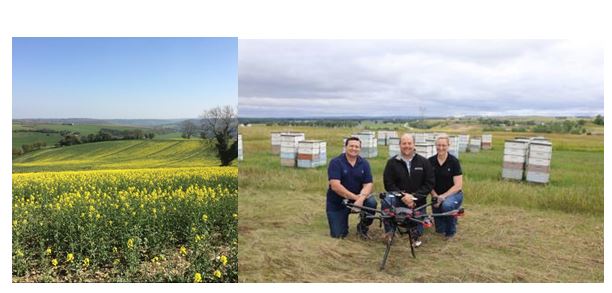IMAGE: A crop field; and David Lyall, Paul Snyder and Kate Lyall
Credit: Dr. Antony Dodd; University of Bristol
Jenny Schlecht; Forum News Service
Could Biological Clocks In Plants Set The Time For Crop Spraying?
Dr. Antony Dodd, Senior Lecturer in the School of Biological Sciences and senior author of the paper, said: “This proof of concept research suggests that, in future, we might be able to refine the use of some chemicals that are used in agriculture by taking advantage of the biological clock in plants. Approaches of this type, combining biotechnology with precision agriculture, can provide economic and environmental benefits.”
Just like human jet lag, plants have body clocks that are crucial for their life in a world that has day and night. Plant biological clocks make a crucial contribution to their growth and the responses of crops to their fluctuating environments.
In a new paper, published today [Friday 16 August] in the journal Nature Communications, the researchers found that the death of plant tissue and slow-down in growth resulting from the herbicide glyphosate depends upon the time that the herbicide is applied and also the biological clock.
Crucially, the biological clock also led to a daily change in the minimum amount of herbicide that is needed to affect the plant, so less herbicide was needed at certain times of day. This provides an opportunity to reduce the quantity of herbicides used, saving farmers time, money and reducing environmental impacts.
In medicine, “chronotherapy” considers the body clock when deciding the best time to give a medicine or treatment. This new research suggests that a similar approach could be adopted for future agricultural practice, with crop treatments being applied at times that are most appropriate for certain species of weed or crop. By employing a form of agricultural chronotherapy might have a future role in the sustainable intensification of agriculture required to feed the growing population.
‘Plant circadian rhythms regulate the effectiveness of a glyphosate-based herbicide’ by Belbin FE, Hall GJ, Jackson AB, Schanschieff FE. Archibald G, Formstone C, Dodd AN in Nature Communications.
______________________________________________________________________________________________________________________________________
High-Tech Pollination Program Begins Work In ND Sunflower Fields.
By: Jenny Schlecht Forum News Service
BISMARCK, ND — Bee boxes sit to the west of Clark Coleman’s sunflower field north of Bismarck. Honeybees play a vital role in pollinating sunflowers, helping increase yield and quality. But up until now, the bees have been placed nearby and farmers hope for the best.
“Bees pollinate, but they don’t know where,” explains Kate Lyall, who owns and operates Australian agriculture technology company Bee Innovative with her husband, David.
Bee Innovative believes it may have an answer that could increase profitability for farmers and make better use of a dwindling resource — honeybees.
According to the Bee Informed Partnership, 37.7% of managed honeybee colonies were lost during the 2018-19 winter — the highest level since the partnership began surveying winter loss after the winter of 2006-07. While problems with colony collapse disorder — when the majority of worker bees leave a colony — have lessened to an extent in recent years, concerns about overall bee health continue.
Those concerns have led researchers to consider whether technology can play a part in pollination. For some researchers, that means looking into whether technology can replace bees. Harvard researchers have created RoboBees, insect-sized flying robots, and about a year ago, they found ways for the robots to fly untethered from power supplies. Numerous researchers are seeking ways to use tiny drones for means of artificial pollination. Walmart filed a patent for a system for “pollinating crops by unmanned vehicles.”
But in North Dakota — annually the No. 1 or No. 2 honey producing state in the country — researchers aren’t trying to use technology to replace pollinators. They’re trying to use technology to make honeybees more efficient.
“I think this is a better option because it’s using what’s already in the natural landscape,” Kate Lyall says. “We’re just making better use of that commodity.”
In August, the Lyalls brought their radar-like technology to North Dakota. Kate Lyall explains the device they created emits an energy signal that can see where bees are and where they’re not. Using that data, they work with beekeepers to bring in more bees, strategically placed for where the field hasn’t been pollinated.
“It’s about providing the farmer with data that they currently don’t have,” she says.
Bee Innovative started using the technology in Australian blueberry and raspberry fields. The blueberries saw increases in both yield and quality, as well as 80% less waste, and more of the blueberries were considered a premium, rather than standard, product, Kate Lyall says.
“We’ve had amazing results,” she says.
Bee Innovative will compare two nearly identical sunflower fields during the course of the study. To do so, they need to use larger drones and are relying on expertise from the University of North Dakota.
Bee Innovative came to North Dakota through a partnership with UND and a $59,113 grant from the North Dakota Agricultural Products Utilization Commission. The UND Aerospace School is providing an additional $10,000 for personnel and equipment.
The Lyalls say they searched the world for knowledge on unmanned aerial systems and landed on UND as the most knowledgeable place.
Paul Snyder, assistant chairman and director of the UAS program in the Aviation Department at UND Aerospace and the principal investigator on the project, says UND’s programs seek to solve problems for industry and they are excited to see where the Bee Innovative partnership leads.
“This kind of technology, I think, is really unique. I mean, we’re tracking the movement of bees,” he says. “It’s just so exciting to see that, because when you start tracking the movement of bees, what’s next with technology?”







